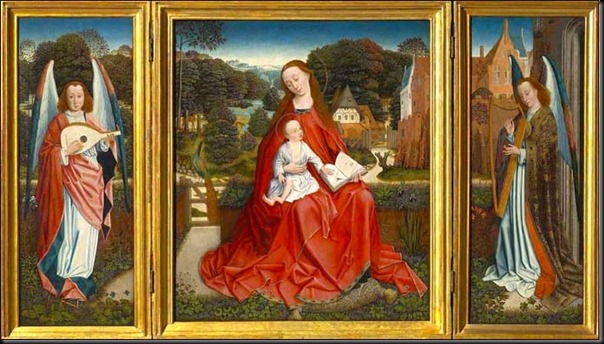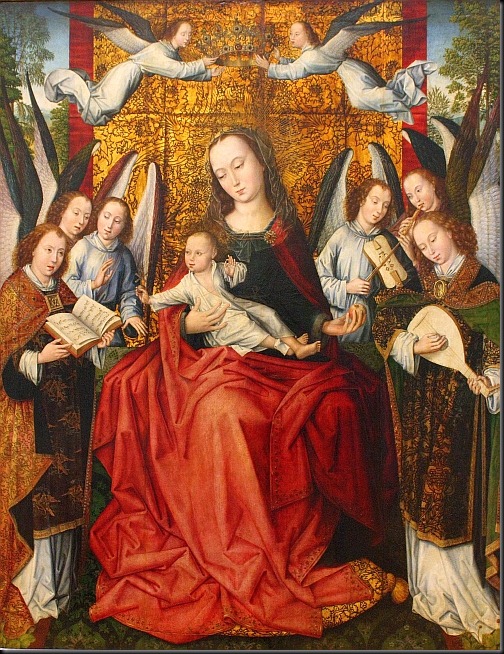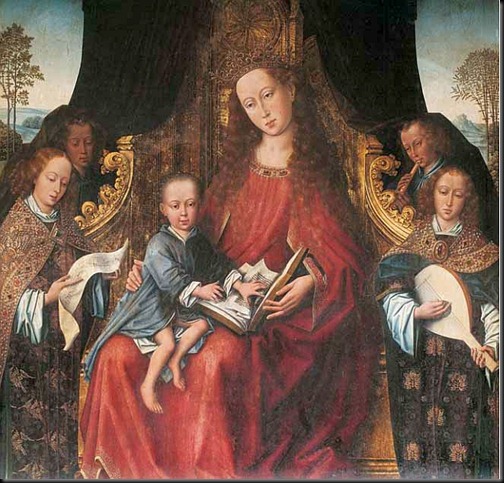THE MAGIC OF CROCHÊ
Saturday, May 28, 2011
Outlook Error Sending
Friday, May 27, 2011
How Long Does An Icecube Take To Freeze
title character of today's entry is not his name. Flemish painter, working in Brussels at the end of the fifteenth century, evidently referring to the artistic conventions developed by Rogier van der Weyden - enough is known about him ... But where did the idea to write about him? As you know, students love to do a variety of charts. PhD students among the most beautiful walking sticks, counting how much time a professor during the lecture says, "truism is ..." or other such tables, and carefully created wykresiki statistics, arousing a smile on the faces of successive cohorts. Similar entertainment are also students of art history, because how many ranking of the best you can do neckerchiefs some lecturers. During one of the tours after a certain amount of alcoholic drinks to evaluate an idea who the artist was the funniest nickname. He won the champion today featured embroidered foliage. So let's draw a bit more of his mysterious character.
Pictured next to the altar, depicting the Madonna with Child and angels muzykującymi located in the Museum of Fine Arts in Lille. This is one of the best works of the Master, but not famous. So let's start with the fact that Master embroidered foliage is not the only inhabitants of the Netherlands and the Flemish, who received an unusual nickname from art historians. Women's Champion Półfigur little work we can even see the National Museum in Poznan ("Lady in Toscana"), and Jan van Stoevere increasingly identified with a certain Master of the Madonna on the grass. Adding to the equally exotic names such as Champion Hortus conclusus (probably Willer van Tanger), Manny Rain Master, Master of The Holy Blood and the separation over the past decades, the Master of the Master of Flemalle Flemalle - hand I and Master of Flemalle - Second hand (it sounds at least funny ...), with You can easily see that the Netherlands employed many talented artists whose personal details have been blurred, however.
reasons of creating such complex names, be sought in the subject of their paintings. Usually, if other regions are not created such unusual nicknames, but the thematic unity Dutch paintings is very difficult. Because how much it might be the Champions Legends of Mary Magdalene? (And there was such an anonymous artist working in Malines). Another Madonna and the holy cause, that they should focus more on the style of these works, odmiennościach formal, not the content of paintings. This is the way managed to set the working poor. Dutch primitives, and so acting mainly in the second Call. Painters of the fifteenth century, where you could assign them to specific images, but it was impossible to find them bibliographic data.
6 years ago when the museum in Lille, organized the first exhibition devoted to the history of the only Master embroidered foliage, hardly anyone expected that this will develop knowledge about it, and artists like him. So far, the problem was mainly scattered works and how they compare to state with probability close to certainty, that actually came from the hand and brush of the Master. This is the way to next flagship works of other French cities such as Amiens, or across the ocean (Philadelphia) analyzed the work of Mexico City and the famous altar of Polizzi Generosa, Sicily.
presented next to the altar, situated in the collections of the Louvre, also is tied to the Master embroidered leaves. This time also we are dealing with a similar theme, but otherwise solved. Angels concentrated in the main field imaging, and their number causes visual clutter, the emphasis on the figure of Mary. Child, however, seem clearly interested in these creatures, one reaches his hand toward as if you wanted to play with him. According to many researchers Champion embroidered foliage focused primarily on the specific background of each style, especially the crown. Landscape, therefore he was in his role, which also fits in the complex development of this subject was in the fifteenth century. Many paintings in fact can be explained as a kind of summy nature - appeared next to each other rare animals, high cliffs almost sprang from the banks of rivers and seas, and cities and agricultural work as a complemented farthest plan.
look again at the first painting (from Lille). Show the same way Madonna is not particularly creative and fold clothes similar find in other great artists of this period, such as Martin Schongauer whether that Rogier van der Weyden. In the second or the Child does not focus on skonwencjonalizowanej pose, emphasizing its historical role. For example, in Madonna Duran from around 1440, hanging in the Prado of Madrid, presented the Child as Rogier card reading books,-held by Our Lady ( link ). This idea clearly seems to be very creative and in many paintings Netherlands from the fifteenth century we find similar behavior, being able to easily trace the evolution of these performances.
What, however, in the case of the Master embroidered foliage seems to be the most important is the emphasis on outstanding ornamentyzację work. Many works of the late Middle Ages and early Renaissance Transalpine has the features by emphasizing the details of a number of religious symbolism and complicated meanings. It is through these works iconology originated, allowing for an understanding of how trivial it might seem parts of the world could be understood as referring to the history of salvation. For example, stressed the lily purity and innocence of Mary, because in the "Song of Songs" (Song 2.1 and 7.3), the author of the bride compared to the plant, and the violet was a symbol of humility. This time the union was still further, because the red color in the middle of the flower was treated as a reference to the prophecy of Simeon, from the Gospel. Luke (Lk 2:35: "a sword will pierce your soul"). This understanding of the world presented can be found in many paintings created in Europe, especially in the Netherlands in the fifteenth century
therefore looking at the work of the Master Embroidered leaves on two representative works for him, we are not able to see these flowers or at all for such an understanding of nature. In return, the recipient before the eyes appears to be intricately painted with the gigantic nature of the detail and often painted each leaf individually. In painting it is manifested very clearly one of the phases of the evolution of landscape painting in the fifteenth century in Flanders and Brussels area developed since then a new way to link the artistic achievements of the international Gothic style and the nascent naturalism. Sacred Space, hitherto almost completely subordinated to the theme of the stage and the main group compositional, "breaks away" from those kind of characters and begins to live his own life. " Even in such a schematic picture of how Paris, the grass and the trees merge imperceptibly with green cloth situated next to the throne.
Master Tech embroidered foliage is perhaps most noticeable in the altar located in Polizzi Generosa, the small, four-thousandth of a village near Palermo, famous for the more that is born there, Martin Scorsese and Domenico Dolce. But it is worth visiting a local church, not only to participate in the annual procession in honor of St.. Gandolfo Sacchiego, but also look at the Madonna and Child of this Master. Readers who are interested in a few lines above the image link to the Madrid Rogier van der Weyden, no need to argue that painting from Sicily is a copy of their processed. A similar solution with child viewers of the book (the work looks to me personally at least once painted over at a later stage) was complemented by figures of angels, closely adjacent to the beautifully decorated throne, Mary. Connected so the idea of \u200b\u200baround 1440, with the one who applied the Master himself in the Parisian image. Similarly, therefore, placed the tree in the background, which on the one hand, duplicate the borders of the picture, on the other, direct the viewer's attention toward the corners, paintings, giving the illusion of natural, not a fairy-fantastic space.
joke would be calling the Master of embroidered foliage Seurat predecessor, but a close look at his work indicates that many plants and leaves are created with tiny dots instead of the obvious brush strokes. It is a pity, therefore, that the artist was not associated with any name, because maybe it would be fascinating to trace his biography and find the reasons for this unusual technique. For these reasons, the study now turn to the reconstruction of late medieval artists' studios, the relationship between the master and the assistants (the hero of today's post probably also painted landscape backgrounds for other painters in Brussels). Hence, a little sad that with an expression of the soul and hands of the artist, we can not even explain the obvious about him, as the dates of life, creation, art education, or just personal details. For though art history is not always necessary for happiness (and sometimes complicated by the potential interpretations) sometimes it is worth to give a human face to the scientific findings.





